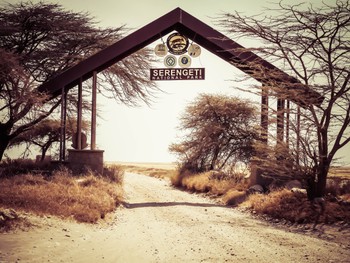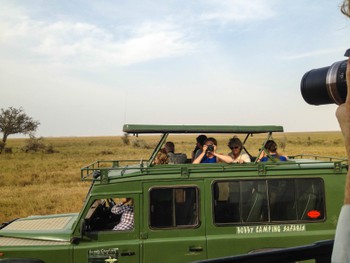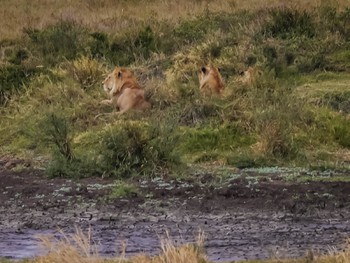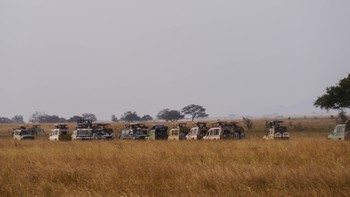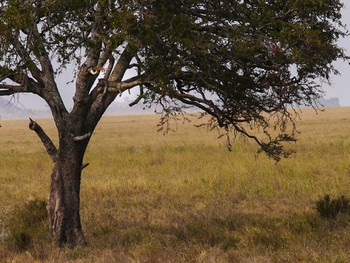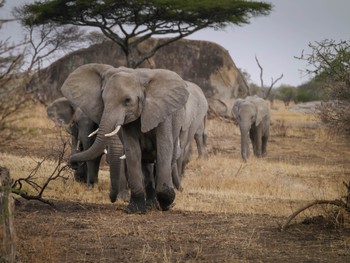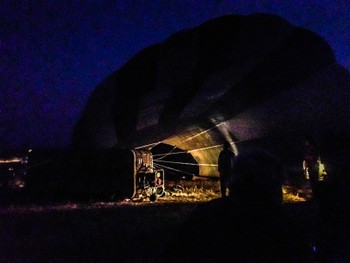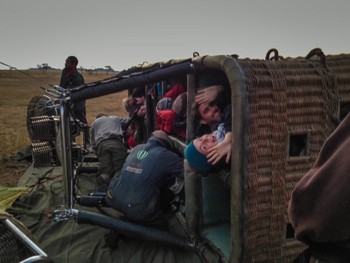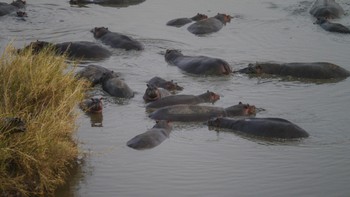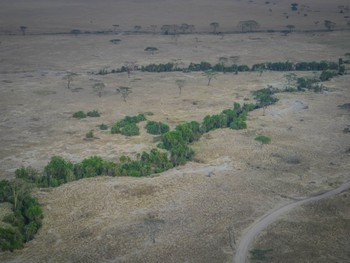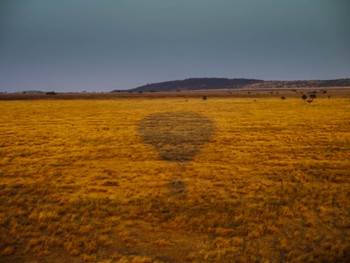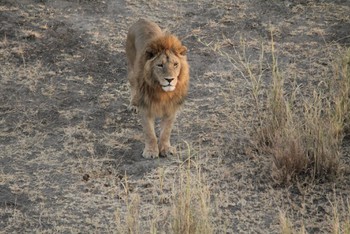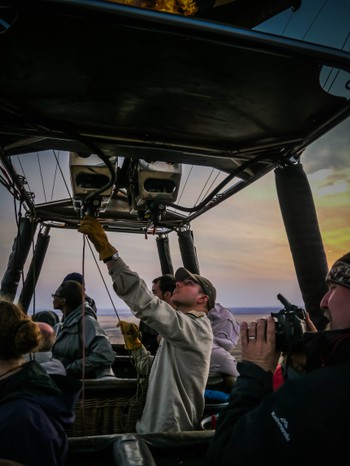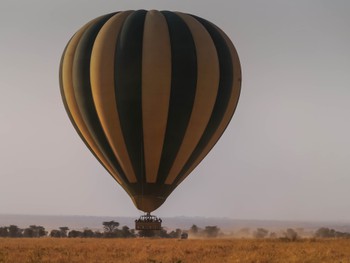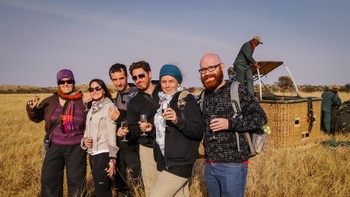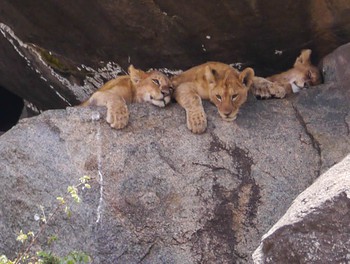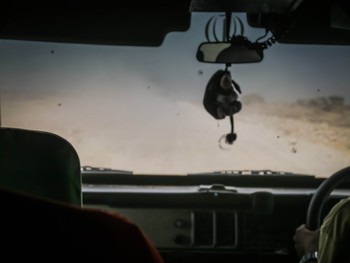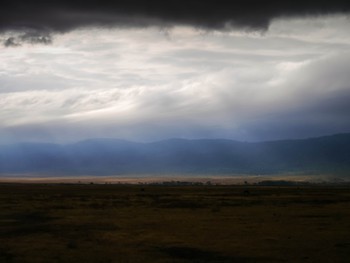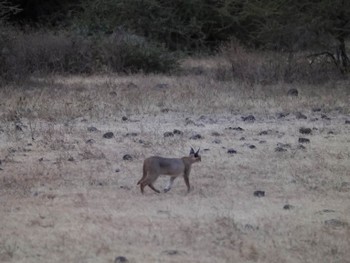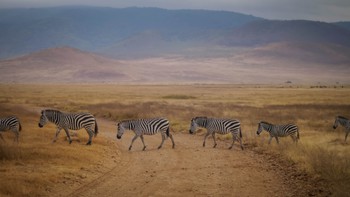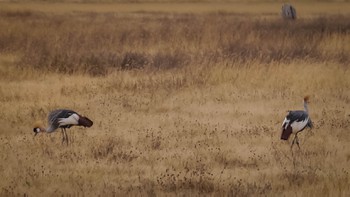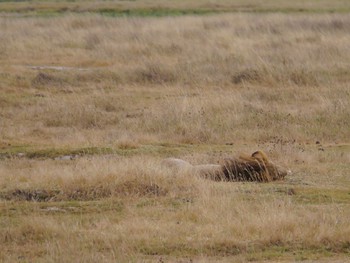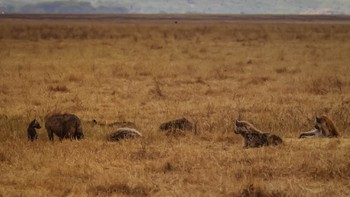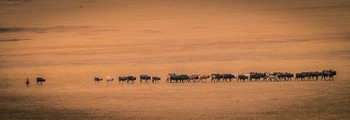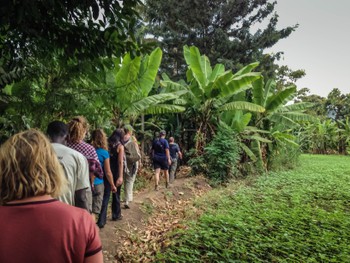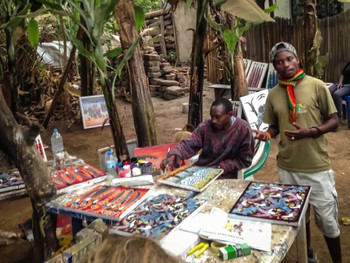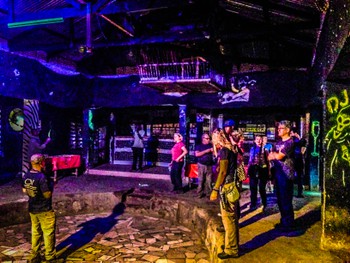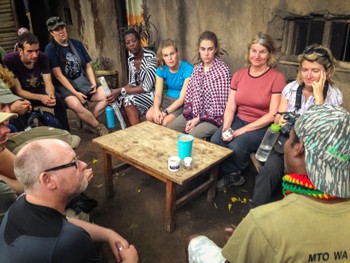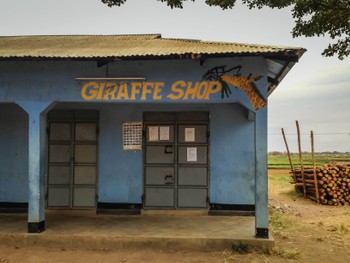Serengeti National Park and the Ngorongoro Crater
So the main draw card for visiting Tanzania was in fact not to go and laze about Zanzibar, rather it was to go and visit the Serengeti National Park and the Ngorongoro Crater, some of Africa's best known big game parks.
We left our overland truck behind and divided off into a number of safari Landrovers with just enough clothing and food for the few days we'd be in the parks.
To get into the Serengeti we needed to drive up over the rim of the crater (but not into the crater), past where we would be camping the following night. As we drove up the temperature dropped quite noticeably, and at the top we stopped at a lookout point where there was a pretty spectacular view of the crater. We then descended down another side of the crater and into the Serengeti.
It had been very dry for quite some time apparently, which meant that vehicles going in and out kicked up heaps and heaps of dusk. A lot of the dirt roads leading up to the Serengeti park entrance was a very rich red, which made some beautiful vistas where you'd have a very pale green and yellow hill with a dark red line cut through it, with an almost painted looking red gradient fading down wind of the road for 10-15M and a few meters upwind of it. It's hard to really describe it well with words, so here's a photo!
Anyhow, on our first day in the Serengeti we saw a ton of stuff. Not long after we got into the main part of the park we passed 4-5 lions sleeping, which had surprisingly few other vehicles stopped around them. In these parks you often seem to find the big 5 by just looking for the clusters of 4WDs.
That is actually how we found two leopards sleeping in trees, so far from the road you couldn't see them with the naked eye. All the stopped vehicles got us to stop and try and work out what they were looking at, and then through binoculars you could make them out lying in the forks of trees and see their tail hanging down.
Of course we saw a whole lot of the more common stuff too. We had a small herd of elephants that were approaching the road and walked right passed our Land Rover less than a few meters away. There were several hyenas roaming about, heaps and heaps of Grant's and Thompson's gazelles, a few heart beasts, and a lot of lovably ugly warthogs.
That night we actually camped in the Serengeti. They do have dedicated camp areas there, but don't get the wrong impression. There are no fences and you really are camping out in the wild. We were instructed to set up out tents with a few meters gap between them, just in case elephants or hippos came through so that they'd have enough room to pass rather than just walking straight over tents; and not long before bed several people saw a hyena shaped silhouette with lit up eyes from the torchlight. Sadly, being a heavy sleeper, I slept through any animal sounds that may or may not have been made that night.
We were instructed that if we woke up in the middle of the night and heard noises, to just stay in out tents and be quiet, and don't turn on any lights. If you need to go to the toilet, hold it. If you cant hold it, wake up your tent buddy, shine a torch outside the tent looking for eyes, then go right there next to the tent while your buddy keeps watch and deal with it in the morning. I was glad to be someone who very rarely needs to get up in the middle of the night!
We were up well before sunrise the next day for one of the major trip highlights, hot air ballooning over the Serengeti! We were collected in 4WDs and driven to the site where they where getting things set up. It was interesting to see how they inflate the balloons with huge fans to start off with the basket on it's side. They then squeeze everyone into their compartments while it's still on it's side and you feel a bit like an astronaut about to blast off to the moon, lying flat to the ground looking up towards the moon in the still dark sky.
The burners begin getting fired and the balloon slowly rises, eventually tipping the basket upright. The actual take-off was so gentle you don't even feel the balloon lift off, just all of a sudden you're no longer on the ground and moving. It's very surreal very surreal.
Each balloon held 16 passengers and a pilot, and there were three balloons going up that morning. Our group was 15 people and we ended up getting a balloon to ourselve!
During the balloon flight we saw our first hippos of the Serengeti, probably 20-30 of them concentrated in the water and dashing about nearby. From the roads the park feels like a completely flat and dry, yellow savannah; but from the air you see the gashes of green carved through the yellow where the waterways runs through, and there's actually quite a lot of animal activity in and around these parts.
We got to see the sun rise from the air, after which the balloon started casting a nice shadow silhouette on the ground.
As we flew further over the park we passed over a few lioness' and one very majestic male lion with a huge big mane who just sort of looked up at us, wondering what the heck we were I guess. I stupidly had my camera recording video so here's a photo a friend took:
Most of the animals didn't seem to pay us much attention although we did manage to startle some buffalo when we were flying quite low, firing the burners caused them to look up suddenly and then dash off a short distance before realising we weren't a threat. At one point we were gliding so low that the basket actually skimmed over the top of an Acacia.
Just as we were landing we spotted a hyena chasing down a gazelle. Everyone was pretty disappointed to be told we had to get back into the take off position for safety, where we were unable to keep watching. The landing was very smooth; not quite as unnoticeable as the take off, but still hardly a bump or drag along the ground and we were stopped on the ground, upright and everything. Our pilot had mad skills!
Upon landing we had a Champagne breakfast and were told the entertaining story about French ballooning pioneers, which rather than reinterpret I'll quote here:
The creation of the hot air balloon dates back to the 1700s, and the first flight occurred on Oct. 19, 1783 in France.
In 18th century France, there were educated people living in the city and there were landowners and peasants in the country. People in the rural areas often had little contact and connection to what was going on in the city.
So, picture this, you are a peasant working in the fields and all of the sudden you see this balloon floating through the air with fire coming out of it. Is it an alien? An attacker? For peasants who hadn't heard of hot air ballooning, the sight of a balloon falling from the sky surprised and often frightened them; especially when they saw the pilot's face covered in black from ash and soot from the fire keeping the balloon aloft.
To avoid being attacked by the people they surprised, hot air balloon pilots carried Champagne or wine with them as a way to let onlookers know they were human and to thank them for the safe landing in their field.
So there you have it, Champagne is the way to settle down rowdy French farmers when you're trespassing on their property!
The breakfast was very fancy, even by western standards. As we approached the tables there was a guy with a basin and a jug of warm water who'd pour it so you could wash your hands, and them dry them with a real cotton towel! The table settings wouldn't have been at all out of place in a fancy restaurant, and as we got closer I could smell my old friend bacon, sizzling away somewhere.
Having not had bacon since leaving home, I would have been happy if they'd served me just a plate of bacon, but there were eggs, sausages, fruit, coffee and juice... It was like a real English breakfast and then some!
To make the day even better, when we got back to camp Charles had make us pancakes and bacon for brunch! Could a day be any more perfect!?!
After brunch we got back in the Land Rovers for an afternoon of game driving with a general meander towards the gate of the park, during which we managed to spot a log more awesome animals. We found 3 lion cubs sleeping in a crevice between some rocks, then a bit later we found a cheetah, and a bit later still two more cheetahs!
We also saw a lion that was standing up in long grass looking around, who then sat down and completely disappeared, making it very clear how hard it could be to spot these animals if they were trying to hide.
The drive out seemed like it was 10x as dusty as the drive in; even with large gaps between our vehicles and us rapidly closing our windows every time we passed another car, everything in the Land Rovers was covered in a thick coating of dust by the time we got out of the park.
We headed back up to the crater rim to Simba Camp where we were staying the night. It was freezing cold that night and although there were showers with a hot tap, the water that came out was barely room temperature and even that quickly ran out leaving only icy water for those who wanted relief from the dust.
It was so cold that night that I wore pretty much every layer I had plus my Goretex wind shell, and still wasn't particularly warm. I headed to bed pretty much straight after dinner and was thankful that our thick canvas tents held heat so well.
Simba camp was another unfenced camp ground, but again if there were animal sounds I managed to sleep right through them. We got up before dark and packed down camp in order to get to the Ngorongoro Crater park gates for opening, with a light drizzle of rain coming down on us.
As we descended into the crater the temperature rose very slightly, but the weather in that crater is completely different to that only a few KM outside of it and it remained pretty grey and cold all day.
Not long after passing the gate someone in out truck spotted some ears in the grass. We backed up to have a better look and found a small cat called a caracal. Were told they themselves aren't rare, but it's quite rare to see them. Steve had never seen one in all his years in Africa, and our driver who's in and out of the park all the time hadnt seen one in 4 years.
In contrast to the steep walls of the crater, the bottom of it was mostly quite flat, with lots of open plains, some forested areas and a few large watering holes.
We saw several elands in the forests, and hundreds of wildebeast and zebra out roaming the plains.
We saw a pair of birds call grey crowned cranes which our driver explained to us were married, as in they were paired for life, but if divorce statistics are to be believed that's probably no longer a great analogy.
We did manage to spot one male lion sleeping in the grass, and several females sleeping in the distance, but because the weather was cold the big cats were mostly sleeping, and sadly for us were largely well away from the road.
What we didn't see in terms of big cats was largely made up for by the number of hyenas we saw around. We must have seen at least 4-5 separate individuals or groups, one of with was a full family with a number of cubs playing. Very cute for a part of "the ugly 5"!
On the drive out of the park, back to civilisation where we were camping that night, we learnt a few tidbits about the Masai culture that partly explained how it can be normal to have multiple wives without a huge gender imbalance, or a lot of men having no wives.
The number of wives a Masai man has is directly related to how many cattle he has, so having lots of cattle means lots of wives. The interesting part we learnt about was that the non-monogamy/polyamory that goes on apparently works in both directions. A man has many wives, but if he goes to visit one and finds a spear dug in the ground outside of her house, it means she has a male guest "visiting," and that the husband should go and find a different bed to stay in that night, we're told all with no jealousy!
I don't think that means that a woman actually has multiple husbands, but it does offer a bit of an explanation why wifeless men aren't rioting about there being no available women because of the greedy guys with all the cattle.
After we arrived at camp, and those of us camping had set up our tents, we were taken on a village tour of Mto Wa Mbu village. We took a very long walk though their farms, through large fields of beans, tomatoes, tapioca, rice, bananas, and numerous other food plants. We were shown the different materials that the people used to build their houses. The cheapest materials being mud houses, the mid-cost ones being made of red bricks, and the most expensive also being the most ugly, cement houses.
We were taken to a local art gallery, where the locals can get taught to paint for a living, and shown the two main styles of art common in Tanzania. And boy were they common, the paintings here were 90% the same largely generic ones we'd seen from Zanzibar onwards. There was a token guy putting the finishing touches on a piece, but as always seems to be the case the piece was pretty much done and he was putting a border on it, so for all we know the paintings are mass produced in a factory and then that guy paints a border on when tourists come past. They're all so same-y that I would not be surprised. It's a shame they're not teaching them to utilize their creative differences instead of teaching them how to be human photocopiers.
There were one or two exceptions, painting completely unique from everything else on display. One of a one zebra really struck a chord with me, but I held off the urge to buy it because I didn't want to be stuck dragging it around with me for weeks until I got back to somewhere with a reliable postal system.
One detour to the normal tour itinerary was a visit to see the local nightclub. We saw the sign and were intrigued and asked about it, and they were all too happy to have us have a look inside at them cleaning and setting things up. It felt kind of like something out of rave movie from the 90s, completely with a dance pit, and raised up DJ booth, and also a cool bar made of concrete and beer bottle ends.
The last point of interest on the tour was a stop at the local bar, to drink some of the locally made banana beer. It's made with a special type of banana and sprouted millet and fermented for a few days giving it a alcohol percentage of roughly 1-2%. The flavour was actually not particularly banana-ry, but the price was dirt cheap! 1000 Tanzanian shillings for 0.5L, or roughly $0.30!
And that pretty much wraps up the time we spent in Tanzania. There was some fun to be had crossing the border into Kenya, but that's material for the next post :)
